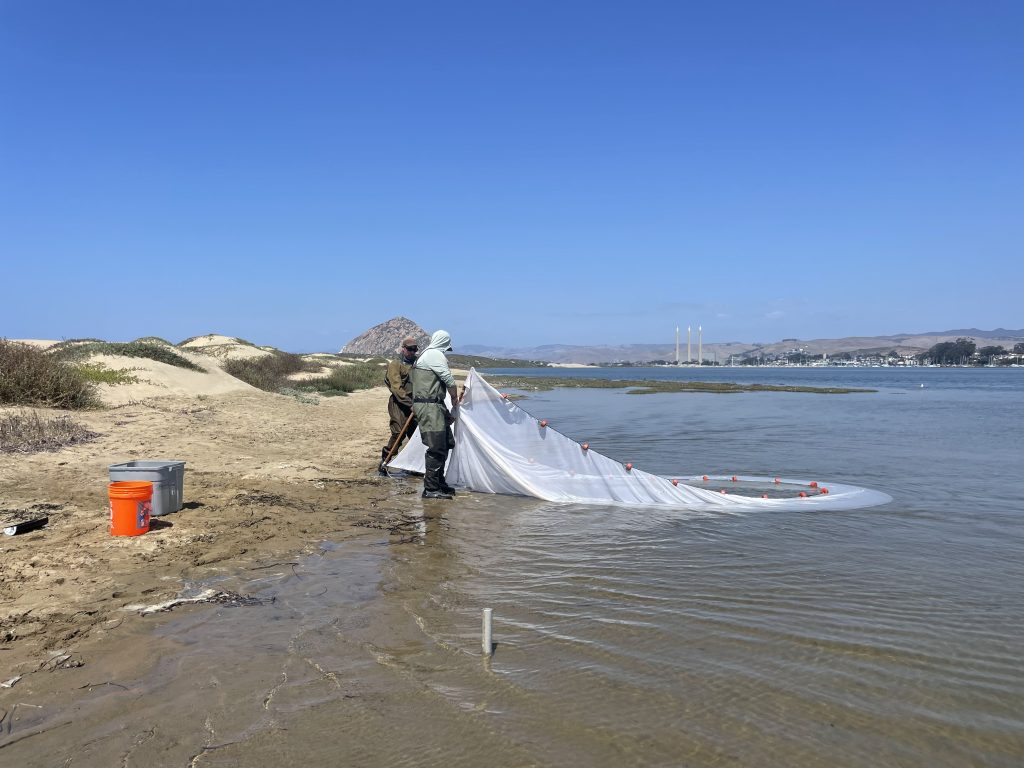The Morro Bay estuary provides an ideal habitat for many different species of fish thanks to its shallow waters, eelgrass beds, protection from waves, and more. While some local fish can be found in a wide range of habitats, many species have adaptations that allow them to thrive in specific environments such as those found in the Morro Bay estuary. These species are known as “habitat specialists,” and their numbers and health can be impacted by changes in the estuary over time. Let’s look at three habitat specialist fish species and their adaptations that make them well-suited to live in the Morro Bay estuary.

Kelp Pipefish
Kelp pipefish (Syngnathus californiensis) are found on the coast from Bodega Bay in Northern California down to southern Baja California. These fish, named for their long, slender bodies, are in the same family as seahorses (Syngnathidae). They are commonly found in eelgrass beds, where their resemblance to blades of eelgrass helps them camouflage. They are not strong swimmers, so blending in with the eelgrass helps keep them safe from predators. Because of this close association with eelgrass, it’s no surprise that fish surveys conducted following the steep decline of the bay’s eelgrass indicated a reduced pipefish population. With the return of eelgrass, preliminary fish surveys have found an increased pipefish population in the bay.

Speckled Sanddab
Sanddabs are a species of flounder found on the coast from the Gulf of Alaska to Baja California. Although they can be found offshore, they usually remain close to the coast on muddy or sandy seafloors. Sanddabs are easily recognizable because they have both eyes on the same side of their body. The sanddab is a “left eye” fish, meaning that both eyes are located on the left side of its body. This is in contrast with the halibut, which is a “right eye” flounder species that is also found in the Morro Bay estuary.

Speckled sanddabs are smaller in size than the Pacific sanddab and are generally not fished commercially due to their small size. Their color can range from tan to olive with black, grey, or brown spots. This coloration helps them blend in with the sandy estuary or sea floor, where they burrow and wait to ambush their prey. Due to their preference for sandy or muddy sediment, fish surveys conducted in Morro Bay during the eelgrass decline indicated an increase in speckled sanddab populations.
Pacific Staghorn Sculpin
The Pacific staghorn sculpin is one of several sculpin species found in the Morro Bay estuary. They are named for the gill covers that extend into antler-like projections on either side of their heads. They are closely related to cabezon (Scorpaenichthys marmoratus), a sculpin species often caught by local anglers. While Pacific staghorn sculpin are also frequently caught, they are typically released back to the water due to their small size.

The staghorn sculpin can tolerate a high range of salinity, from freshwater to extremely saline. This tolerance is important for estuary-dwelling fish since salinity levels can fluctuate due to freshwater input, tides, and more. They are also capable of breathing when outside of water for short periods of time and can be found in environments like tidepools. Larval sculpin begin life in the estuary where they burrow into the soft, sandy sediments. Juveniles may move into freshwater creek habitats, then return to brackish or saltwater to spawn. Staghorn sculpin require high quality habitat both in the creeks and the marine environmental in order to thrive.
Protections for Morro Bay Wildlife
The Morro Bay estuary is one of 124 Marine Protected Areas (MPAs) in California. An MPA is a marine or estuarine area that protects marine life and habitat, including fish. The Morro Bay MPA includes a State Marine Recreational Management Area (SMRMA) and a State Marine Reserve (SMR). By regulating the types of activity that can occur within them, MPAs enhance biodiversity and protect habitats while provide recreational opportunities for people. You can learn more about MPAs on the California Department of Fish and Wildlife website or at californiampas.org.
References
https://phys.org/news/2021-10-morro-bay-seagrass-loss-fish.html
https://wdfw.wa.gov/species-habitats/species/citharichthys-stigmaeus#desc-range
https://calfish.ucdavis.edu/species/?uid=62&ds=241.%C2%A0
https://www.pierfishing.com/pacific-staghorn-sculpin/
https://www.nps.gov/articles/000/sculpins.htm
https://wildlife.ca.gov/Conservation/Marine/MPAs/Definitions#mpa
Help us protect and restore the Morro Bay estuary!
- Donate to the Estuary Program today and support our work in the field, the lab, and beyond.
The Estuary Program is a 501(c)3 nonprofit. We depend on funding from grants and generous donors to continue our work. - Support us by purchasing estuary-themed gear from ESTERO. This locally owned and operated company donates 20% of proceeds from its Estuary clothing line and 100% of Estuary decal proceeds to the Estuary Program. Thank you, ESTERO!
- Purchase items from the Estuary Program’s store on Zazzle. Zazzle prints and ships your items, and the Estuary Program receives 10% of the proceeds.
- Subscribe to our seasonal newsletter: Between the Tides!
- We want to hear from you! Please take a few minutes to fill out this short survey about what type of events you’d like to see from the Estuary Program. We appreciate your input!